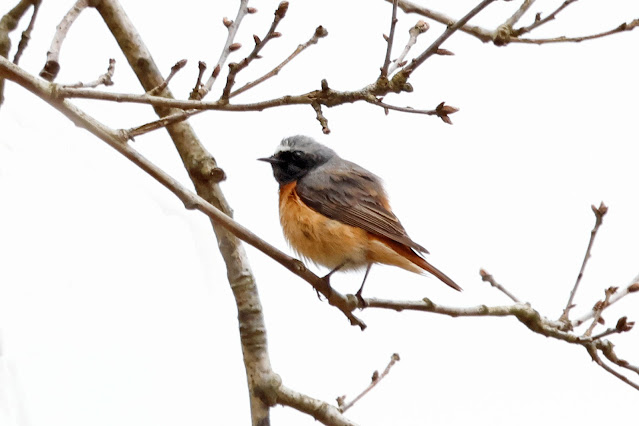After our six hour marathon around the Keyhaven - Lymington Reserve we decided to head into the New Forest for a specialty that had just arrived. It was a half hour journey to the car park at Pig Bush, from where we set off through the surrounding woods with Blackcap and Chiffchaff singing. Coming out of the wood onto the heath we disturbed a Stonechat amongst the dead bracken.
Movement in the bracken a little further on prompted a search of the bracken from where I flushed a Dartford Warbler that appeared for seconds then just disappeared.
We followed the main path up the ridge and then down the other side towards the bridges and and streams alongside the birch trees. Here a Blackcap was in full song amongst the birch and willow trees and was quite prominent at the op of the branches for once.
A Cuckoo called from distant trees, we thought we had found it but just could not be certain. We crossed the boggy area and almost lost Ian as the ground gave way under his left foot. You have to be careful because what looks like ground to walk on can suddenly be a bog.
We were heading to a group of trees that stretched to the railway line. There was plenty of song coming from the trees but not the one we were hoping for, then Ian had a brief glimpse of a female Redstart, so they were about. The area is one of marsh bog and fallen trees, ideal for the Redstart. having seen one we started a more concerted search around the trees and bushes and it didn't take long to find a male. It dropped from a tree briefly to the ground before flying back up. It was moving through the trees and I just managed to get a quick record shot.
We walked slowly around the area, hoping to catch a glimpse. The hope that we had in coming here at this time of year was that with the leaves only just starting to emerge there was a chance we could get good views. Our approach over the years has been to go to Acres Down at the end of April, by then the trees were in leaf and the Redstart would sing from the tops of the trees and the views would be adequate. The Redstart is one of the smartest British birds and as yet I have never managed to do it justice with a photograph. We were hoping that today would be the day to put that right, however it had not started well.
We then saw the female again and she was joined by the male. They would give themselves away by dropping to the ground to pick up food and then return to a prominent branch to watch. We decided to stand and watch nd this approach produced results.
The male in all his glory
He would follow the female around, the female keeping out of sight in amongst the branches, while the male was prepared to be more open.
These were already some of the best Redstart photographs I have taken.
Redstarts are real tree-dwellers, nesting and feeding in mature
oak woodlands and sometimes hedgerows in western parts of the UK. They
are temperate rainforest specialists, thriving in the wet, mild
conditions of the coastal woodlands of Wales, Scotland and South West England.
Back into the trees.
From the bracken it flew back into the trees and we decided to walk on. There is a circular walk that leads back to the car park. The Cuckoo could still be heard calling away in the distance, closer though was a Willow Warbler in the young birch trees by the fence. A Woodlark flew from the top of a tree and dropped down amongst the bracken.
Coming out the other side we were faced with a line of birch trees with leaves just beginning to emerge.







































No comments:
Post a Comment